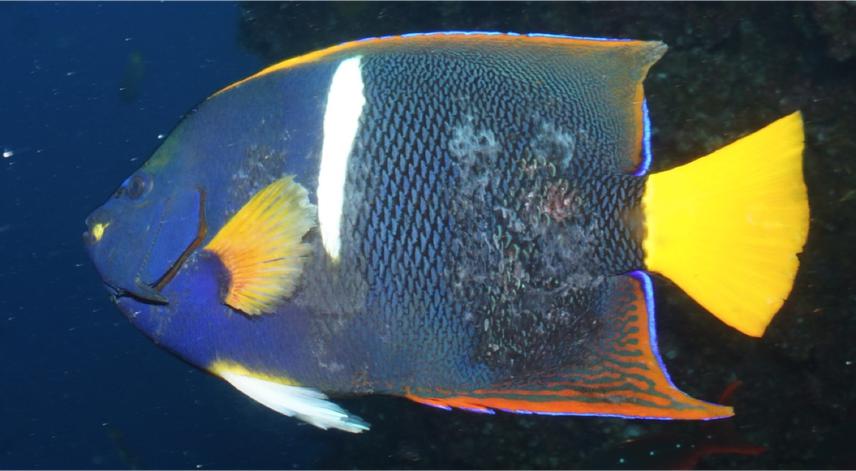Social media video featuring the project.
Cashes Ledge: Jewel of the Gulf of Maine
16 Nov 2016 Puerto Ayora, Ecuador, Central and Latin America Fishes | Biodiversity
Anthropogenic Threats to Mollusk Populations and their Ecological Role on the Continental Coast of Ecuador
Fish Diversity in the Galapagos Islands: Implications for Marine Reserve Management and Ecosystem Functioning
We are working to understand the impacts of the extreme 2016 El Niño event on Galapagos reef fish communities. Our two primary aims are a full epidemiological analysis of a novel wildlife disease hypothesized to be triggered by El Niño, and an evaluation of the immediate and long-term effects of El Niño on the entire reef fish community.

HOPA sick.
The 2015-16 El Niño event caused sea surface temperatures throughout the Galapagos Islands to rise 3°C above normal. This anomaly persisted almost unceasingly between September 2015 and April 2016. The most striking manifestation of the event was a novel fish disease (“disintegrating skin disease”), which we have observed in at least 20 species of reef fish at multiple sites in the Galapagos. We postulate that this disease is linked to warm surface waters and high temperature variation at the onset of El Niño, and aim to investigate prevalence rates in wild fish populations, geographical extent, effects on individual performance and population demographics, and environmental triggers. In addition, we will determine whether there is an ecological effect of disintegrating skin disease through mechanisms including decreased fecundity due to the extra metabolic demands of fighting disease, direct disease mortality and disease-induced exposure to predation, and poor body condition and decreased ability to feed.
In addition, El Niño warming of the surface of the ocean causes up-welling to cease. This stagnation of the oceanic conveyor belt and the food resources it brings causes ecosystem-wide decline as plankton, the basis of Galapagos marine food webs, becomes scarce. We will evaluate the capacity of replicate, semi-closed fish populations to maintain stability or rebound from perturbation based on predictions that draw from life history characteristics, range of movement, zoogeographic origins, and feeding relationships. We will also test the hypothesis that sites with strong up-welling of cool, nutrient-rich waters persist in a more productive state during El Niño and thus serve as a thermal refuge. Fish surveys will be paired with manipulative experiments to elucidate the role of herbivorous fishes in controlling benthic algal communities and transferring energy into higher trophic levels.
As climate change progresses, extreme weather events such as this are only predicted to become more frequent and intense. Our collaboration with the Galapagos National Park and Charles Darwin Foundation is key for selecting individual fish species and entire geographic areas of the marine reserve at highest and lowest risk of climate-related decline. Indeed, it is thanks to our Rufford-funded reef fish census monitoring program that the novel disease outbreak at the heart of this El Niño event was first recorded.
Social media video featuring the project.
Cashes Ledge: Jewel of the Gulf of Maine